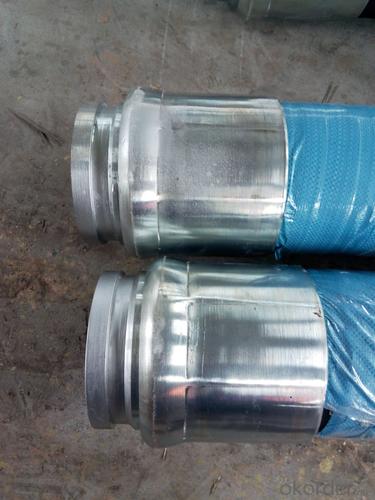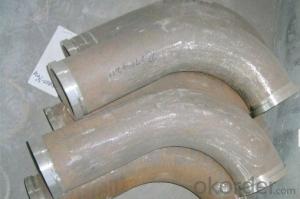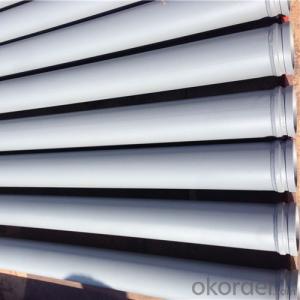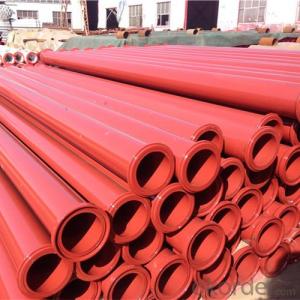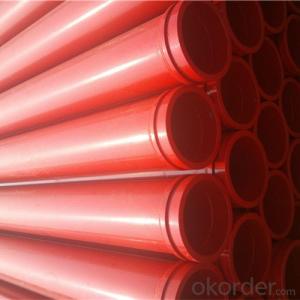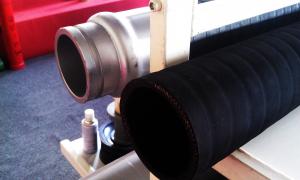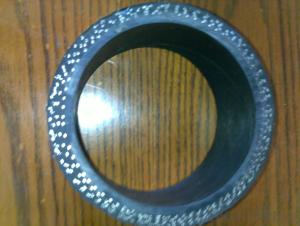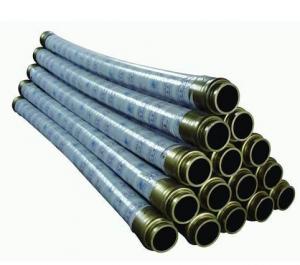Concrete Pump Rubber End Hose with Galvanizing Flange
- Loading Port:
- Shanghai
- Payment Terms:
- TT OR LC
- Min Order Qty:
- 1 PCS
- Supply Capability:
- 1000 PCS/month
OKorder Service Pledge
OKorder Financial Service
You Might Also Like
Product Description:
1. Specification
Concrete Pump Rubber End Hose with Galvanizing Flange1.Size:5 inch
2.Steel hose
3.2 or 4 piles of steel wires for your choose.
Name | Concrete rubber hose; Delivery hose; End hose; Concrete pump hose; Boom hose |
Size | 2"/2.5"/3"/3.5"/4"/4.5"/5"/6"or according to client’s requirement |
Length | 3M,5 or Any length |
Reinforcement | Steel wire, tire cord or fabric |
Hose End | Galvanized, inner wall harden |
Application | Schwing, Putzmeister, Sany, Zoomlion, etc |
2. Application
1.Applacation:delivery concrete
2.Suitable for the various :Schwing, CIFA,PM, Zoomlion ,SANY and so on.
3. Package
Put into containers.
FAQ:
Q1: Why buy Materials & Equipment from OKorder.com?
A1: All products have its ISO certifications, adheres to the highest standards and a commitment to supply chain safety and customer satisfaction.
Q2: How do we guarantee the quality of our products?
A2: We have established an advanced quality management system which conducts strict quality tests at every step, from raw materials to the final product. At the same time, we provide extensive follow-up service assurances as required.
Q3: How soon can we receive the product after purchase?
A3: Within three days of placing an order, we will begin production. The specific shipping date is dependent upon international and government factors, but is typically 10 to 30 workdays.
Q4: If we can produce Concrete Pump Rubber End Hose with Galvanizing Flange according to customers request?
A4: Yes, we can produce ConConcrete Pump Rubber End Hose with Galvanizing Flange according to the difference country situations to make it suitable to the market and customers. We have very professional technical team to make the design.
Q5: How to make a quick resolution for after service?
A5: We have overseas branches all-around of world, If needed, the seller shall dispatch 2 engineers to the buyer's site for supervision of training. The buyer shall make available of necessary facilities &skilled personnel at site for training.
Image:

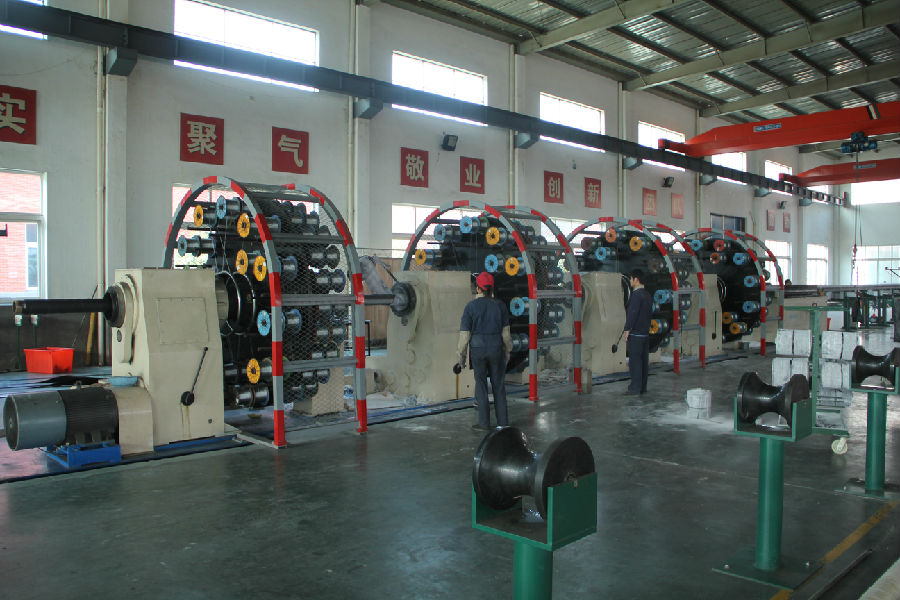
- Q: Are there any specific recommendations for the inspection and testing of concrete pump spare parts?
- Concrete pump spare parts come with specific recommendations for inspection and testing. To begin with, it is essential to visually examine the spare parts for any damage, such as cracks, dents, or excessive wear. Carefully inspect the parts for any irregularities or abnormalities. Next, it is advised to conduct non-destructive testing (NDT) to guarantee the integrity and quality of the spare parts. NDT methods like ultrasonic testing, magnetic particle testing, or dye penetrant testing can be utilized to identify any hidden flaws or defects in the parts. These tests are beneficial in detecting potential issues that might impact the performance or safety of the concrete pump. Additionally, it is recommended to verify the dimensions and tolerances of the spare parts to ensure they adhere to the manufacturer's specifications. Precision measuring tools can be employed to compare the measurements with the required specifications. Any deviations should be documented and addressed accordingly. Furthermore, functional testing should be carried out to ensure that the spare parts are functioning as intended. This involves installing the parts in the concrete pump and conducting various tests to verify their functionality and performance. For instance, the pump's flow rate, pressure, and efficiency can be tested to ensure optimal performance. Lastly, it is of utmost importance to adhere to the manufacturer's guidelines and recommendations for inspecting and testing concrete pump spare parts. These guidelines provide specific instructions and procedures for accurately and safely inspecting and testing each type of spare part. It is crucial to consult the manufacturer's documentation and seek professional advice if necessary.
- Q: Can concrete pump spare parts be heat-treated or hardened for increased durability?
- Concrete pump spare parts can undergo heat treatment or hardening to increase their durability. By subjecting the parts to controlled heating and cooling processes, their mechanical properties can be altered. This alteration significantly improves their hardness, strength, and wear resistance, thus enhancing their durability and ability to withstand harsh operating conditions. Various heat treatment methods, such as quenching and tempering, induction hardening, and case hardening, can be applied to different types of spare parts, including cylinders, pistons, wear plates, and delivery pipes. These processes contribute to the overall performance and lifespan of the spare parts, ensuring their ability to withstand the demanding nature of concrete pumping operations.
- Q: How does a hopper agitator motor ensure consistent concrete mixing?
- A hopper agitator motor ensures consistent concrete mixing by providing a continuous and powerful agitation motion within the hopper. This motion helps to break up any clumps or aggregates in the concrete mix, ensuring that all components are evenly distributed. The consistent agitation also helps to prevent settling or segregation of the mixture, resulting in a uniform and well-mixed concrete batch.
- Q: How can one determine the correct size and dimensions of concrete pump spare parts?
- To determine the correct size and dimensions of concrete pump spare parts, there are several important steps to follow: 1. Identify the specific make and model of your concrete pump: Each concrete pump has its own unique specifications and requirements for spare parts. Therefore, it is crucial to know the make and model of your pump before ordering any spare parts. 2. Consult the manufacturer's documentation: Manufacturers often provide detailed documentation that includes information on the required size and dimensions of spare parts. This documentation may include technical drawings, diagrams, and part numbers that can help you find the correct size. 3. Measure the existing spare part: If you already have a spare part that needs replacement, you can measure its size and dimensions using precision tools like calipers or a measuring tape. Take accurate measurements of key dimensions such as length, width, height, and any other relevant specifications. 4. Seek professional assistance: If you are unsure about the correct size and dimensions, it is advisable to consult with a professional or an authorized dealer. They have expertise in concrete pumps and can guide you in selecting the right spare parts based on your pump's specifications. 5. Consider compatibility and quality: When purchasing spare parts, ensure they are compatible with your concrete pump's make and model. Additionally, prioritize quality to ensure longevity and optimal performance. Buying from reputable suppliers or directly from the manufacturer can help ensure the spare parts meet the necessary size, dimensions, and quality standards. By following these steps, you can accurately determine the correct size and dimensions of concrete pump spare parts, ensuring smooth operation and minimizing downtime.
- Q: How often should hydraulic filters be replaced in a concrete pump?
- To ensure optimal performance and longevity of the equipment, it is important to regularly replace the hydraulic filters in a concrete pump. The frequency of replacement will depend on factors such as the specific model of the concrete pump, the operating conditions, and the quality of hydraulic fluid used. As a general rule, it is recommended to replace the hydraulic filters every 500 to 1,000 operating hours or at least once a year, whichever comes first. However, it is crucial to consult the manufacturer's recommendations and guidelines for the specific model of the concrete pump, as they may have specific maintenance schedules and intervals. Regularly inspecting the hydraulic filters is also vital to determine if replacement is necessary before the recommended interval. If the filters are clogged, damaged, or show signs of excessive wear, immediate replacement is necessary to prevent potential damage to the hydraulic system. Additionally, if the concrete pump operates in harsh or dusty environments, more frequent filter replacements may be required to ensure proper filtration and prevent contamination. In conclusion, timely and proper replacement of hydraulic filters in a concrete pump is crucial to maintain efficiency and reliability, prevent breakdowns, and prolong the service life of the equipment.
- Q: What are the common challenges in sourcing spare parts for stationary concrete pumps?
- Sourcing spare parts for stationary concrete pumps can present various common obstacles. Firstly, availability poses a significant challenge. Depending on the concrete pump's brand and model, locating the exact spare parts needed can prove difficult. Some manufacturers lack a widespread distribution network, making it challenging to promptly locate the required spare parts. This difficulty is intensified if the concrete pump is an older model or if the manufacturer has ceased production. Another significant challenge is cost. Spare parts for stationary concrete pumps can be pricey, particularly when sourced directly from the manufacturer. Alongside the initial cost, additional expenses like shipping, customs duties, and taxes further escalate the overall cost of acquiring spare parts. Ensuring quality assurance is a crucial aspect when sourcing spare parts. It is vital to verify that the sourced spare parts are of high quality and compatible with the specific make and model of the concrete pump. Inferior spare parts can result in performance issues, breakdowns, and potential safety hazards, detrimentally impacting the overall efficiency and lifespan of the concrete pump. Timing also plays a pivotal role in spare parts sourcing. When a concrete pump malfunctions, it can cause delays in construction projects, leading to extra expenses and potential penalties. Therefore, swiftly and efficiently finding spare parts is essential to minimize downtime and ensure smooth operations. Additionally, language and communication barriers can present challenges. If the spare parts manufacturer or supplier is situated in a different country or speaks a different language, effective communication can be problematic. This can lead to misunderstandings, delays, and difficulties in accurately conveying specific spare parts requirements. To overcome these challenges, it is advisable to collaborate with reputable suppliers specializing in concrete pump spare parts. These suppliers often maintain a vast inventory of spare parts, ensuring availability and reducing the risk of delays. Furthermore, establishing strong relationships with local distributors or authorized service centers can streamline access to spare parts and technical support. Regular maintenance and proactive planning can also help mitigate the challenges of sourcing spare parts for stationary concrete pumps. Maintaining an inventory of essential spare parts and components can minimize downtime and ensure smooth operations.
- Q: Are there any online resources or manuals available for concrete pump spare parts?
- Yes, there are several online resources and manuals available for concrete pump spare parts. Many manufacturers and suppliers have websites where you can find detailed information about various spare parts, their specifications, and ordering details. Additionally, there are online marketplaces and forums dedicated to construction equipment, where you can find comprehensive catalogs, user manuals, and even discussion threads related to concrete pump spare parts.
- Q: How can one source reliable suppliers for concrete pump spare parts?
- One can source reliable suppliers for concrete pump spare parts by conducting thorough research, seeking recommendations from industry professionals, checking customer reviews and ratings, and verifying the supplier's credibility and experience in the market. Additionally, attending trade shows and exhibitions related to the construction industry can provide opportunities to connect with reputable suppliers.
- Q: How does a concrete pump clamp work?
- A concrete pump clamp is a device used to secure and hold the different components of a concrete pump system together during operation. It acts as a connector between the pipes, hoses, and couplings in the system, ensuring a tight and leak-free connection. The clamp generally consists of two halves that are tightened together using bolts, creating a strong grip around the components. This tight grip prevents any movement or separation of the pipes and hoses, allowing for efficient and safe concrete pumping.
- Q: What are the indications of an inaccurate concrete pump pressure gauge?
- There are several indications that can suggest an inaccurate concrete pump pressure gauge. Here are a few: 1. Inconsistent readings: If the pressure gauge consistently gives varying readings even when the concrete pumping conditions remain constant, it could be a sign of an inaccurate gauge. For example, if the gauge displays a pressure of 1000 psi one moment and then jumps to 1500 psi without any significant changes in the pumping operation, it could indicate an issue with the gauge. 2. Unusual or abnormal readings: If the pressure gauge consistently displays extremely high or low pressure readings that are significantly different from the expected values, it could signify an inaccurate gauge. It is important to be aware of the typical pressure range for the specific concrete pumping operation to identify abnormal readings. 3. Incongruity with other gauges: If there are multiple pressure gauges installed in the concrete pumping system, and they provide significantly different readings, it could suggest that one or more of the gauges are inaccurate. Comparing the readings of various gauges can help determine if a particular gauge is faulty. 4. Inadequate pump performance: If the concrete pump is not performing as expected, such as experiencing reduced output or inconsistent flow rates, it could be due to inaccurate pressure readings. Inaccurate pressure measurements can affect the control of the pump's hydraulic system, leading to inefficiencies in pumping operations. 5. Physical damage or wear: Any visible damage or signs of wear on the pressure gauge, such as cracked glass, bent needles, or loose connections, can compromise its accuracy. Such physical damage can lead to inaccurate readings and should be addressed promptly. It is important to regularly calibrate and maintain the pressure gauge to ensure accurate readings. If any indications of an inaccurate gauge are observed, it is recommended to consult a professional technician or engineer to assess the situation and take appropriate actions to rectify the issue.
Send your message to us
Concrete Pump Rubber End Hose with Galvanizing Flange
- Loading Port:
- Shanghai
- Payment Terms:
- TT OR LC
- Min Order Qty:
- 1 PCS
- Supply Capability:
- 1000 PCS/month
OKorder Service Pledge
OKorder Financial Service
Similar products
Hot products
Hot Searches
Related keywords



